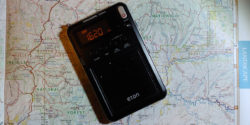One of life’s little pleasures is tuning around the radio dial late at night before drifting off to slumber. I especially enjoy this while traveling, touring foreign radio dials, encountering strange and distant signals.
This means that a small portable radio is my constant traveling companion. I prefer to travel light, so said radio must also be as tiny as practical. In the last couple of years the Tivdio V–115 has been my choice, given its small size, AM, FM and shortwave tuning, reasonable sensitivity and ability to record air checks to a microSD card. I’ll refer you to my YouTube review for more details.
Even so, my ears are always wandering, urging my eyes to admire other receiver suitors. About a month ago the Eton Mini Grundig Edition caught my attention, and at a sale price of less than $25 delivered. Grundig is a venerable name in radios, and the Mini has received decent reviews, so I bit.
Small and Capable
The radio lives up to its name, measuring up to about the same size as an iPhone SE, including a decent speaker and retractable antenna. It comes with a nice nylon case to help protect it in your bag.
Though the Mini includes shortwave, the coverage is more limited than my Tivdio, only covering two bands, from 5 – 10 MHz and 11.65 – 18 MHz. That said, shortwave is more of a “nice to have” than a necessity for my travel radio, so this limitation is fine with me.
Taking it along for an extended trip to New York City and northern New Jersey, I was impressed at how well it pulled in FM stations inside my Midtown Manhattan hotel. It was no problem tuning in public radio WNYC, along with college radio from NYU, Columbia University and Fordham. The same could not be said of the room’s supplied clock radio.
Though small, the Mini’s speaker is adequate for a travel radio, with pleasing sound that’s loud enough for hotel room listening. You’re not going to disturb your neighbors, and that’s probably a good thing. I also appreciate its simple thumbwheel tuning. It’s not quite as convenient as the number direct-dialing keypad on my Tivdio, but the Tivdio’s buttons are stiff and make a loud click, which can annoy others around you if you’re scanning the dial wearing headphones.
For late night listening a sleep timer is a necessity, since I’m likely to drift off, sometimes to the soothing sounds of inter-station static. The Mini comes so equipped. I also appreciate its control lock that prevents it from turning on inside my baggage, draining batteries and annoying fellow passengers.
Patience Pays for DXing
After dark is the time for AM band DXing, and here I found the Mini’s performance curious. When I first spun the dial, I was only picking up the strongest local stations. Then I started clicking through frequencies more slowly, stopping when I heard a faint signal. Leaving the radio tuned, the signal grew in volume and strength – patience paid off. I suspect this is an artifact of the DSP-based tuner, keeping the volume more muted with a weak signal so as not to assault the listener with loud static, then gradually increasing sensitivity as needed.
Moving from noisy Manhattan to the relative quiet – both in terms of noise and RF interference – of upper Passaic County, I enjoyed many fun DX finds. Keeping the gradual technique in mind, I had no problem bringing in signals from Quebec, Michigan, Ohio, Western Pennsylvania, Upstate New York and Boston. I didn’t formally log the stations because I was already tucked into bed with the lights out.
On Halloween night I dived into the shortwave band a little after dusk, wondering if I might encounter some pirates. I wasn’t hopeful, and so I wasn’t disappointed when none emerged from the ether. I was, however, pleasantly surprised when Radio Havana came blaring through at 6 MHz.
At home in Portland, Oregon, I’ve found shortwave reception inside my house to be very hit and miss, and mostly miss. I do think geography is partly to blame. New Jersey is simply closer to many more shortwave stations than Oregon. Nevertheless I was impressed with how good the Eton Mini’s indoor shortwave reception is.
On the whole, the Eton Mini Grundig Edition proved itself a capable and pleasant traveling companion. The one thing I miss is the easy ability to record airchecks direct to a memory card like my Tivdio can. However, I think the Mini outclassed it with AM sensitivity and selectivity, provided you’re patient and allow maybe a half-minute for a station to slowly come into focus through the static. Also, the Tivdio’s recording circuit can be a source of interference, which means it can thwart recordings of weak signals which will just disappear when you hit record. Moreover, if I’m listening to the Mini through the speaker I can make quick-and-dirty aircheck recordings using my smartphone or a portable voice recorder (yeah, I often travel with one of those, too).
There are better performing portable radios, and ones with more features or frequency coverage. But I don’t think I’ve encountered one this small and also this good. Carry on and tune in.



